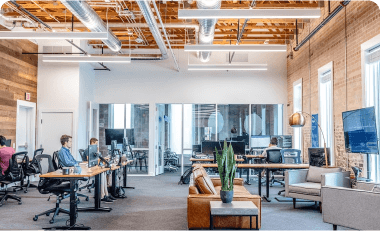
Achieving Business Agility with Data-Driven Decisions in Office Design
In the rapidly evolving business landscape, one concept has gained significant prominence: agility. At the heart of company agility is the capacity to quickly adjust to changes in the market atmosphere. This includes strategic, operational, and technological aspects and the physical workspace where employees collaborate and create value. In this context, data-driven decision-making in office design has appeared as an essential enabler of business agility.
Embracing a Data-Centric Approach to Office Design
Traditionally, office design has been based on subjective elements, such as aesthetic preferences, assumptions about employee needs, and corporate culture. However, such an approach often leads to a disconnect between the workspace and the actual requirements of the employees. A data-centric approach to office design remedies this by incorporating objective insights derived from various sources, including employee surveys, workspace utilization data, and productivity metrics.
By understanding and analyzing these data points, businesses can create an office environment that enhances productivity and improves employee engagement and well-being. The analysis may reveal unexpected insights, for example, a correlation between certain spatial configurations and productivity levels or the impact of natural lighting on employee morale.
Unleashing Business Agility through Data-Driven Office Design
A well-designed office that aligns with employee needs and preferences can dramatically improve agility. For instance, it can foster a culture of collaboration and innovation, leading to faster decision-making and problem-solving. It can also enhance the flexibility of operations by accommodating different workstyles and job functions, thereby enabling quick realignment of resources in response to market changes.
Additionally, a data-driven approach to office design allows for continuous improvement. Regular collection and analysis of relevant data help businesses understand how their office design impacts their performance and what adjustments may be necessary. Thus, office design becomes an ongoing process of learning and adaptation rather than a one-time project, mirroring the agile mindset.
Facilitating Employee Engagement and Well-Being
Data-driven office design boosts agility and plays a critical role in promoting employee engagement and well-being. By designing spaces that cater to employees' needs for comfort, convenience, and privacy, businesses can make them feel valued and respected. This not only enhances their job satisfaction and loyalty but also their mental and physical health, resulting in lower absenteeism, turnover, and higher productivity.
Moreover, employees feel more engaged and committed when their feedback and preferences are considered in office design decisions. They understand that their voice matters and that the organization values their input. This boosts their motivation and morale, thereby contributing to business agility.
The Role of Leadership in Data-Driven Office Design
The shift towards a data-driven approach to office design requires strong leadership. Leaders must champion the importance of data and analytics in office design and ensure that the necessary resources are allocated for data collection and analysis. They must also foster a culture that values evidence-based decision-making over intuition or convention.
Leadership is also crucial in balancing the insights derived from data with the unique aspects of the organization's culture and identity. While data can provide valuable insights, it should consider the nuances of the organization's character, which often hold the key to employee loyalty and engagement.
Conclusion: The Competitive Edge of Data-Driven Office Design
In conclusion, data-driven decision-making in office design can significantly enhance business agility, employee engagement, and well-being. It provides a competitive edge in today's fast-paced business environment, enabling organizations to adapt to changes and maintain high-performance levels swiftly. By harnessing the power of data, businesses can create workspaces that reflect their culture and values and empower their employees to thrive. The result is a dynamic, agile, and resilient organization ready to navigate the complexities of the modern business world.
Hybee, a leading provider of data-oriented solutions, offers a comprehensive platform designed to streamline and enhance your hybrid workspace. Hybee empowers organizations to save time, optimize resources, and deliver an exceptional employee experience by leveraging data-driven insights. One of the key advantages of Hybee is its ability to harness the power of data analytics. By analyzing the data collected from employee preferences, space utilization, and resource allocation, Hybee provides valuable insights that drive informed decision-making. This information allows organizations to optimize resources, identify underutilized areas, and allocate space more effectively. By leveraging data-driven recommendations, companies can reduce costs, improve workspace efficiency, and create a more productive work environment.













